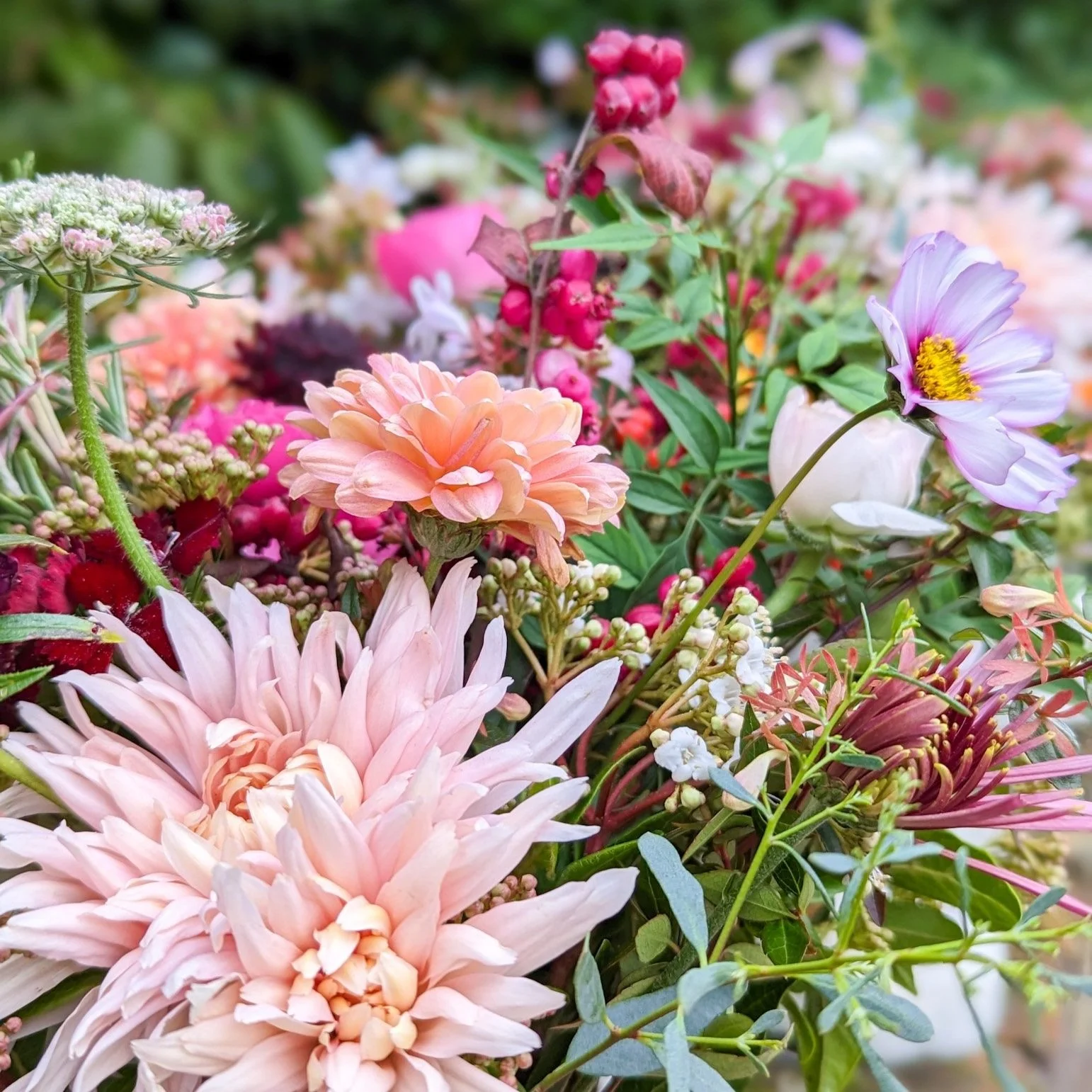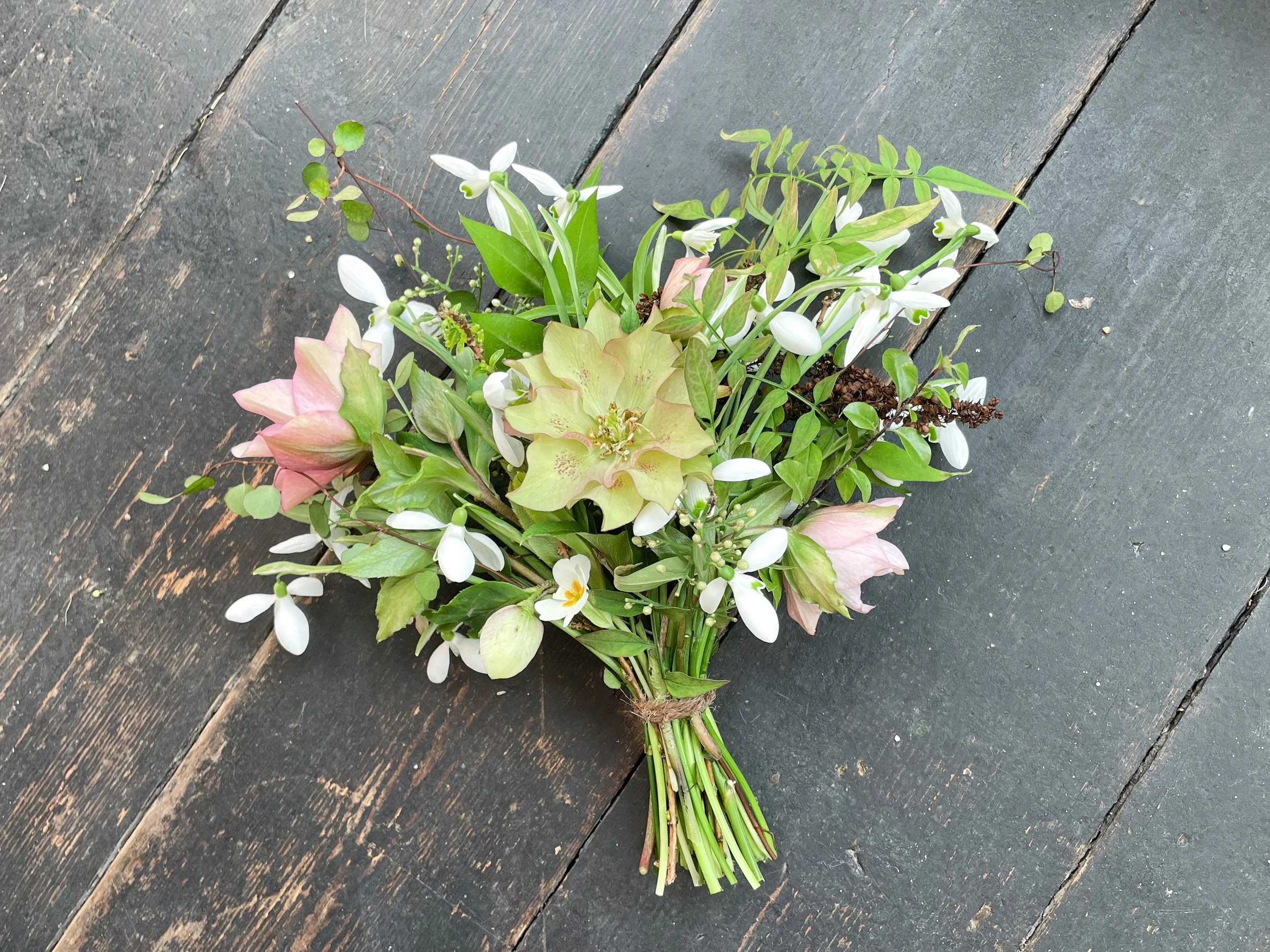Why buy British flowers?
A colourful array of British flowers in November - chrysanthemums, snowberry, flowering shrubs.
I’m a bit embarrassed to admit it, but until I started growing, it never even occurred to me to question the provenance of the flowers I bought.
I bought flowers I thought were pretty, maybe even with some eco-credentials such as non-plastic packaging, but where they had come from just wasn’t something I thought much about.
But as my interest in growing flowers took hold, I discovered the British flower movement and all the wonderful benefits of buying locally grown flowers. And I got a reality check on the impact of the imported flowers I had unquestioningly consumed.
Shockingly, around 85% of flowers sold in the UK are imported, often from Holland or other countries as far away as Kenya and Ecuador*. In fact the vast majority of flowers you’ll find from the supermarket, high street florist, or online flower company are imported.
Sustainability is a tricky subject, and the last thing any of us should be doing is judging each other’s choices. The decisions we make about our habits and consumption are based on so many factors, like access, resources and knowledge.
But I think now we are all striving to do better, in whatever way we can, and buying more local or British produce is a great way to make a difference.
So what is the argument for British flowers?
The flowers themselves
One of the biggest reasons to buy British flowers is, well, the flowers! British flowers are completely beautiful, full of unique charm and incredible fragrance. They are flowers as nature intended.
Imported flowers have been bred to cope with international shipping and year round production. They are grown with chemicals and commercial methods that keep them straight, sturdy and long lasting, but often rob them of their natural qualities and their scent. They are usually refrigerated on their long journey to the UK, so whilst they may look fresh, they are usually weeks old by the time they reach you, the consumer.
They also don’t mirror nature in the same way locally grown flowers do, which for such an innately ‘natural’ product just doesn’t feel right!
Roses don’t grow here in February, so why would we want to buy or receive them for Valentine’s Day? The rows of perfectly straight, perfectly tight red roses in the shops don’t do justice to the real, authentic love they are supposed to represent.
By contrast, a bunch of daffodils or narcissi for Mother’s Day in March is a beautiful and symbolic representation of the bond between mother and child through the centuries, originating because children would pick them wild on the way to church on Mothering Sunday. How much more meaning does a gift of flowers have, when it represents exactly what was in bloom in the moment it was gifted?
The downside, of course, is that there aren’t many British flowers available to buy during Winter, because there simply aren’t many flowers growing in nature. But there is always beauty to be found outside, from a bundle of winter foliage and berries in December, to a handful of hellebores cut from the garden in January.
Seasonal florists like me will usually have a gifting option in the off-season (I dry flowers all summer to use during the Winter months), but plants are also a gorgeous alternative for a flower loving friend. A potted hyacinth to fill their kitchen with scent or a bare root rose to plant in the garden - the options are endless, and full of so much more meaning than a hastily ordered bunch from an online giant.
And when the flowers start blooming again in early Spring - that is a joy you can only truly feel, when you’ve also felt their absence through the Winter.
By buying local flowers, you get the real deal - freshly picked, gorgeous, interesting flowers that reflect the seasons and fill your home with amazing fragrance. And once you start buying British, you’ll never look at those supermarket bunches in the same way again.
A posy of British flowers in February - hellebores, snowdrops, foliage and seedheads.
The environmental argument
The environmental impact of the flower industry is huge.
Studies have found that the carbon footprint of a bunch of imported flowers is around 10 times higher than British grown blooms, and 20 times higher than a locally grown bunch*.
In fact, a study found that a bouquet of just 10 stems of flowers grown in Holland and Kenya has carbon emissions of approx 32kg CO2 - over half the emissions of a flight from London to Paris which comes in at 58KG CO2*.
Buying British, and as locally as possible, allows you to cut the long supply chains on your flowers, reducing the carbon footprint by a huge amount.
Many big online florists claim to be ‘sustainable’, even using using misleading claims and terminology to convince consumers of their green credentials (see @greenwashtheflowers for more on this).
But the truth is that buying local is the most sustainable choice you can make when it comes to flowers, and it can only have a positive impact on our local environment too.
Here in London, like many urban areas, air quality and biodiversity are a cause for concern. But flowers help, attracting pollinators and other wildlife, which in turn supports our natural eco system. Plants are proven to improve air quality by absorbing carbon dioxide and releasing oxygen, and flowers are critical part of that lifecycle.
So by supporting your local growers, and florists who use local flowers, you are supporting the establishment, continuation and expansion of flowerey green space, with all the environmental benefits it brings. That’s definitely good news for our local area.
Finding British flowers
Of course, making up less than 15% of flowers sold in the UK, British flowers can be harder to get hold of. But that’s where I come in!
If you live in South East London, join the Flower Club for a monthly delivery of the most gorgeous British blooms, cut from my garden and local farms, and delivered straight to your door. Or have a look in the Flower Shop to see what’s in season now.
Or if you live elsewhere, try Flowers From the Farm, the membership association for artisan growers of flowers here in the UK, which has a really useful postcode search function allowing you to find all the local growers in a particular area.
That means that whether you’re sending flowers to your friend in Scotland, your Mum in Cornwall, or a business contact in Birmingham, you can find a florist or grower in their area to make them a local bunch. Easy!
*Facts and figures from a study by Rebecca Swinn: A comparative LCA of the carbon footprint of cut flowers: British, Dutch and Kenyan (Lancaster University 2017).

